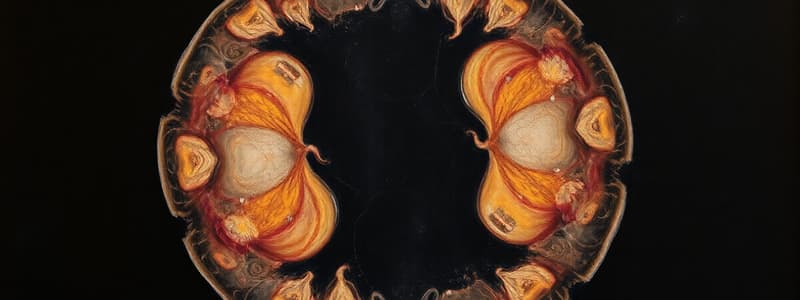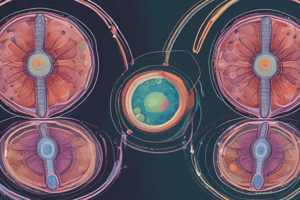Podcast
Questions and Answers
What are the two primary types of cell division?
What are the two primary types of cell division?
Mitosis and meiosis.
Define mitosis.
Define mitosis.
Mitosis is the process of cell division that results in two identical daughter cells.
What is the main outcome of meiosis?
What is the main outcome of meiosis?
The main outcome of meiosis is the production of four haploid gametes.
How does cytokinesis differ in plant and animal cells?
How does cytokinesis differ in plant and animal cells?
What role do checkpoints play in the cell cycle?
What role do checkpoints play in the cell cycle?
Flashcards
Cell Division
Cell Division
The process by which a single cell divides into two or more daughter cells.
Daughter Cells
Daughter Cells
The new cells produced by cell division, usually genetically identical to the original cell.
Cell Cycle
Cell Cycle
Series of events that take place in a cell as it grows and divides.
Genetic Material
Genetic Material
Signup and view all the flashcards
Mitosis
Mitosis
Signup and view all the flashcards
Study Notes
Types of Cell Division
- Mitosis is a type of cell division that produces two identical daughter cells from a single parent cell. It's crucial for growth, repair, and asexual reproduction.
- Meiosis is another type of cell division that produces four genetically unique daughter cells. It's specifically involved in sexual reproduction. These cells are called gametes (sperm and egg).
Phases of Mitosis
- Prophase: Chromosomes condense and become visible; the nuclear envelope breaks down; spindle fibers form.
- Metaphase: Chromosomes align at the center of the cell (metaphase plate).
- Anaphase: Sister chromatids separate and move to opposite poles of the cell.
- Telophase: Chromosomes decondense; nuclear envelopes reform around each set of chromosomes; cytokinesis (division of the cytoplasm) begins.
Phases of Meiosis
- Meiosis I: This phase separates homologous chromosomes.
- Prophase I: Homologous chromosomes pair up (synapsis) and crossing-over (genetic recombination) occurs.
- Metaphase I: Homologous chromosome pairs align at the metaphase plate.
- Anaphase I: Homologous chromosomes separate and move to opposite poles.
- Telophase I: Chromosomes decondense; nuclear envelopes may reform; cytokinesis begins.
- Meiosis II: This phase separates sister chromatids, similar to mitosis.
- Prophase II: Chromosomes condense and the nuclear envelope breaks down (if reformed).
- Metaphase II: Chromosomes align at the metaphase plate.
- Anaphase II: Sister chromatids separate and move to opposite poles.
- Telophase II: Chromosomes decondense; nuclear envelopes reform; cytokinesis completes, producing four haploid daughter cells.
Key Differences between Mitosis and Meiosis
- Mitosis produces two diploid daughter cells; meiosis produces four haploid daughter cells.
- Mitosis does not involve genetic recombination; meiosis involves crossing over during Prophase I.
- Mitosis is used for cell growth and repair; meiosis is used for sexual reproduction.
Control of Cell Division
- Cell division is a tightly regulated process. Errors can lead to uncontrolled cell growth, which is a hallmark of cancer.
- Checkpoints in the cell cycle ensure that DNA replication is accurate and chromosomes are properly segregated.
- Internal and external factors influence cell division.
- Growth factors and hormones play key roles in stimulating or inhibiting cell division.
- The cell cycle is a cycle of events that cells go through as they grow and divide, and this cycle is controlled by different checkpoints.
Significance of Cell Division
- Cell division is essential for the development and growth of multicellular organisms.
- It allows for the replacement of damaged or worn-out cells.
- Cell division is fundamental to reproduction, both asexual and sexual.
- In the development of an organism, cell division is the basis to create specialised tissues and organs.
Cytokinesis
- Cytokinesis is the division of the cytoplasm, and it occurs alongside telophase.
- In animal cells, a cleavage furrow forms and pinches the cell in two.
- In plant cells, a cell plate forms and grows to separate the two daughter cells.
Errors in Cell Division
- Errors in cell division can lead to genetic abnormalities, like aneuploidy (wrong number of chromosomes) or structural chromosomal aberrations.
- Uncontrolled cell division is a key factor in cancer formation.
Asexual Reproduction
- Asexual reproduction involves only one parent.
- Mitosis is the means of cell division in asexual reproduction.
- Simple organisms, such as bacteria, yeasts, and some plants, reproduce asexually.
Sexual Reproduction
- Sexual reproduction requires two parents.
- Meiosis produces the gametes (eggs and sperm).
- The fusion of gametes during fertilization restores the diploid chromosome number.
- This produces offspring with a unique combination of genetic material.
Studying That Suits You
Use AI to generate personalized quizzes and flashcards to suit your learning preferences.




